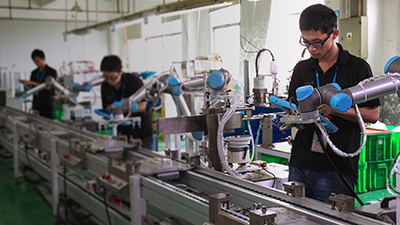
Hazards, Testing & Standards
Mischief Makers: When Robots Cause Accidents
Hazard-free robots and cobots can keep you out of court, if you know where to look for the hazards
Avoiding your robot’s day in court
Seems completely logical that the more robots and cobots there are in the world, the greater the chances are that a robot or cobot will be involved in an incident where bodily harm or property damage to someone or something happens.
The International Federation of Robotics claims there’s 2.7 million industrial robots working jobs around the world. About the population size of Lithuania. With 3.5 million expected by 2025, unfortunate incidents have even a greater chance of happening.
Attorney Kate Browne from Berkshire Hathaway Specialty Insurance has seen enough and offers up a cautionary article on the subject: Who Will Be Sued When A Robot Causes Harm?
 “Advancements in robotics will continue and someday robots may have the ability to learn and operate independently,” she writes. “When they do, there will inevitably be incidents where robots hurt people or damage property. Who will be liable when a robot causes harm? Can a robot be an employee or are they more akin to a pet? Do robots need a legal status that would make them responsible for their own actions?
“Advancements in robotics will continue and someday robots may have the ability to learn and operate independently,” she writes. “When they do, there will inevitably be incidents where robots hurt people or damage property. Who will be liable when a robot causes harm? Can a robot be an employee or are they more akin to a pet? Do robots need a legal status that would make them responsible for their own actions?
“Someday, in the not-too-distant future, lawyers and experts in courtrooms around the world may discuss and debate what evidence is needed to demonstrate the proper programming of a robot. Whether it’s the protocols for updating its software and operating systems, or a defective product or procedure caused by human error or malfunctioning robots.
“Things may get particularly interesting when robotics uses open-source software. Who will be sued when there are millions of “creators?”
Assessing hazards
Pierrick Balaire of In Compliance is out with an informative article that lists potential hazards with which to be forearmed and forewarned.
Robotics is a rapidly growing field with applications in multiple industries and taking many shapes and forms in today’s world. Examples include collaborative robots (cobots), automated mobile robots (AMRs), automatic guided vehicles (AGVs), automated mobile platforms (AMPs), smart mining, autonomous mobile storage for the retail industry, medical robots, and robotic personal assistants.
As these devices become more prevalent, it is important to understand the hazards and testing options for these innovative devices, as well as the various global standards and requirements with which manufacturers and developers will need to comply.
Hazards
There are several hazards that need to be assessed and addressed for robots and robotic devices. The main hazards to consider for robotics are:
- Mechanical: Hazards originating from moving, overspeed, falling, sharp edges, etc., that are caused by the design and function of the system itself must be considered and assessed.
- Electrical: The overall safety and performance of electrical components including insulation, thermal effect, and shock hazard within the device and its peripherals should be considered, particularly in regard to electrical safety standards.
- Ergonomic: These are potential ergonomic concerns related to the design and comfort of the device or system.
- Thermal: Products must be assessed for the potential to overheat, which could result in fire/explosion, burns, or other damage.
- Acoustical/Noise: Operational issues resulting in unwanted or loud noises could arise as a product performs its intended task or function.
- Vibration: Mechanical issues that lead to unwanted or excessive vibration during use. This, in turn, can produce noise and potential damage to the product.
- Radiation: Electromagnetic emissions from the system and its components must fall within a range that is considered safe and acceptable.
- Material/substance: Hazards related to the components within the robot, such as wiring, metals, liquid, etc. must be considered and assessed.
- Environmental: Hazards associated with the specific environment related to the machine’s intended use. For example, in a healthcare environment, potential interference hazards associated with other medical devices and their critical functions.

In addition to individual hazards, it is common to see combinations of hazards, such as vibration and noise (vibration issues will create concerns around noise), electrical and thermal (poor electrical quality leading to overheating), or chemical and radiation. It is important to keep these potential combinations in mind when developing products, so you can mitigate risk in the product design and test appropriately when assessing the device.
Testing Option
To assess the hazards associated with robotics, there are several testing areas that may apply. Depending on the hazard(s), you will need to consider:
- Hazardous locations assessments: Products used in hazardous locations or explosive atmospheres must be assessed to specific, stringent requirements in place for these environments.
- Functional safety evaluation: To ensure a device’s fail‑safe mechanisms are operating correctly and risks are reduced to as low as reasonably predictable, these assessments are vital to qualify or quantify the safety integrity level of safety functions.
- Process evaluations: This may include things like risk management, programmable electrical medical systems, and usability. Process assessments will depend on the individual products, their intended use, and potential environments.
- Mechanical safety testing: These are evaluations that assess machinery and mechanics for performance and safety. These tests should assess potential risks and may also identify some that must be prevented and/or corrected.
- Electrical safety testing: These assessments will help to ensure safe operating standards in relation to the product’s use of electricity. They also illustrate compliance with electrical safety standards required in a given market.
- Performance testing: Assesses attachments like manipulators, visual detection, and acoustical devices for overall performance and endurance to ensure consistency with use.
- Environmental testing: Assessing hazards related to the intended environment to ensure product performance and safety is important. Products used outdoors, for example, will need to be evaluated for components like weather and climate concerns. Products used in industrial settings will need higher endurance factors than those used in homes.
- Electromagnetic compatibility (EMC) & electromagnetic interference (EMI): These tests help to ensure a product continues to function when in use around other devices emitting electromagnetic energy, as well as making sure that a device does not interfere with the operations and function of other nearby products. As more products in use emit EMI, these assessments are increasingly important.
- Wireless and cybersecurity testing: Ensure wireless products meet requirements for connectivity, function and data protection. As the world becomes more connected, it is more important than ever to ensure the security of any product.
Global Standards
In addition to understanding potential hazards and testing options, it is critical to know the standards for robots applicable in the region or market in which a device will be marketed or sold. Often these standards address all or some of the hazards identified and outline testing requirements as well. What is required does vary by market, however, so it’s important to know which standards apply to a given project.
A global standard, ISO 10218‑1: Robots and robotic devices, addresses the safety requirements for industrial robots, systems and integration. This ISO standard has been harmonized and adopted by many countries and regions; however, there are other standards that may apply to robotics in a given area.
See related:
How annoying can a robot become?
Curse of the Digital Workplace: RoboBully
Study Finds Robots Easily Bully Office Workers

